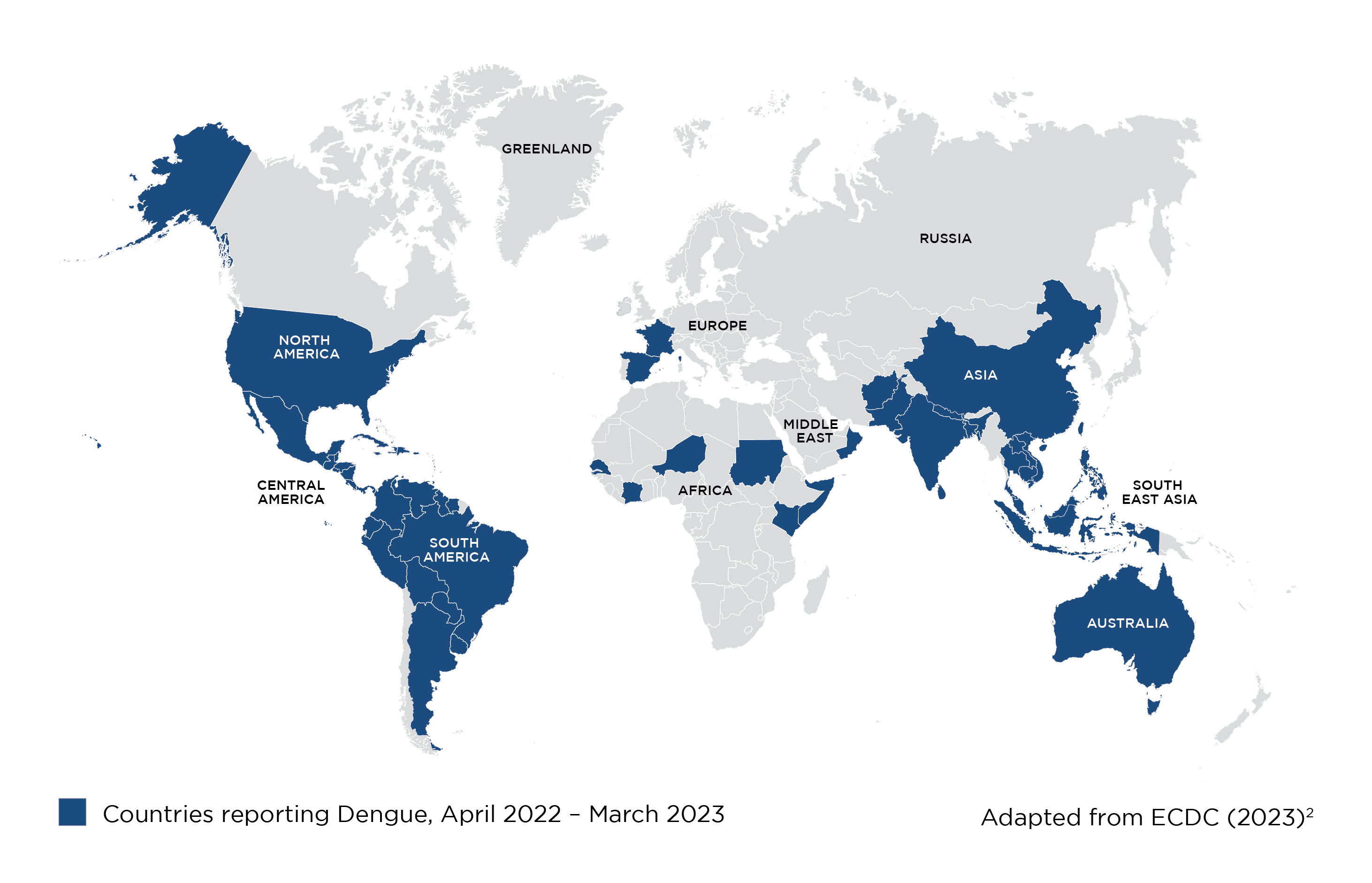The incidence of dengue has increased dramatically worldwide, from around 500,000 in 2000 to over 5 million in 2019. About half of the world’s population is now at risk.1
Risk areas for Dengue Fever

FAQs
-
Key fact
-
How do you get dengue fever?
When bitten by mosquitoes carrying the virus. These mosquitoes can also carry other viruses such as Chikungunya, Yellow Fever and Zika.3
-
Which countries are affected by dengue fever?
Over 100 countries, including Africa, the Americas, Eastern Mediterranean, South East Asia and the Western Pacific are affected. Dengue is also spreading to new areas, including Europe (see map).1,2
-
What are the symptoms of dengue fever?
This virus usually causes an infection which feels like severe flu. Symptoms may include: severe headache, pain behind the eyes, muscle and joint pain, nausea, vomiting, swollen glands or a rash.1
Symptoms usually occur between 4 and 10 days after being bitten, and usually last for 2-7 days1. Therefore, you may start to feel ill when you are back home after your trip.1
-
How serious is dengue fever?
In most cases, dengue is mild. But in rare cases it can be life-threatening.1 In severe cases it can cause fluid to leak out of blood vessels, which can lead to fluid accumulation in the lungs, and difficulty breathing. Severe dengue can also cause bleeding and organ impairment.5
-
Can I prevent getting dengue fever?
You can take the following precautions to help reduce your risk of infection:
- Visit your nearest convenient pharmacy or specialist travel health clinic for a risk assessment before your trip
- Use a recommended insect repellent containing either Picaridin, DEET, PMD or OLE (oil of lemon eucalyptus), IR3535 or 2-undecanone3
- Wear appropriate clothing (e.g loose fitting long-sleeved clothes, long trousers, socks and shoes) to minimise exposed skin4,6
- Use mosquito nets if you are sleeping or resting in unscreened accommodation or sleeping outdoors during the day or night4
Ready to get started? Check now for your nearest travel health clinic.
Get friendly advice from the UK's largest network of travel clinics*.
* This list is not exhaustive and other travel health providers are available.
References
- World Health Organization. Fact sheets. Dengue and severe dengue. March 2023. Available online: https://www.who.int/news-room/fact-sheets/detail/dengue-and-severe-dengue (Last accessed May 2023)
- European Centre for Disease Prevention and Control (ECDC). Dengue virus disease cases reported April 2022 – March 2023. March 2023. Available online: https://www.ecdc.europa.eu/en/publications-data/dengue-virus-disease-cases-reported-april-2022-march-2023 (Last accessed May 2023)
- Centers for Disease Control and Prevention. Yellow Book 2024. Section 4 Environmental Hazards & Risks. Mosquitoes, Ticks & Other Arthropods. May 2023. Available online: https://wwwnc.cdc.gov/travel/yellowbook/2024/environmental-hazards-risks/mosquitoes-ticks-and-other-arthropods (Last accessed May 2023)
- Public Health England. Mosquito bite avoidance: advice for travellers. January 2023. Available online: https://www.gov.uk/government/publications/mosquito-bite-avoidance-for-travellers (Last accessed May 2023)
- Centers for Disease Control and Prevention. Dengue. For Healthcare Providers. Clinical Presentation. April 2023. Available online: https://www.cdc.gov/dengue/healthcare-providers/clinical-presentation.html (Last accessed May 2023)
- Fit for Travel. General Travel Health Advice. Mosquito Bite Avoidance. Available online: https://www.fitfortravel.nhs.uk/advice/malaria/mosquito-bite-avoidance (Last accessed May 2023)
UK-BOTB-2100020 (v2.0) May 2023
